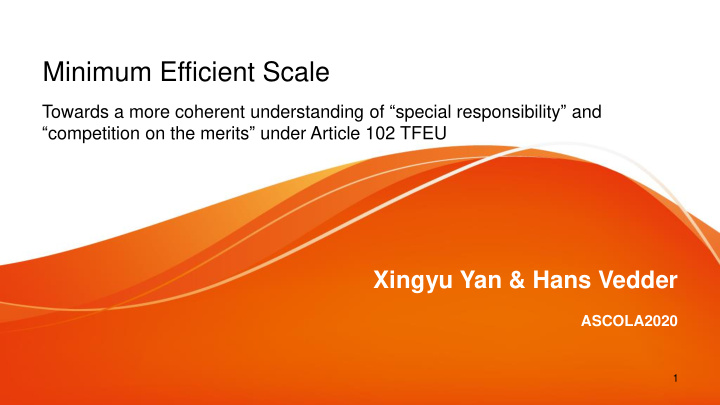



Minimum Efficient Scale Towards a more coherent understanding of “ special responsibility ” and “ competition on the merits ” under Article 102 TFEU Xingyu Yan & Hans Vedder ASCOLA2020 1
Introduction: Two concepts • Competition on the merits (CotM): – as the antithesis of abuse, to acknowledge competition on the part of the dominant firm but, vague – a search for “ inherent impropriety ” , a “ no economic sense ” test? • Special responsibility (SP): – singling out dominant firms: dominance as a constitutive element of unlawful conduct but, vague – a shortcut to the abuse assessment? • Devising an abuse test that balances enforcement precision and cost-effectiveness? 2
Structure of the paper (1) • Part II: situating the two concepts in 102 legal framework – case law instructs a contextualized approach • welcome an illegality presumption • need to honor the dominance premise • Part III: examining the solidity of an efficiency-based conception of CotM – the AEC test is most qualified, albeit imperfect – the no economic sense test is not • “ profitability vs. exclusionary in a non-efficiency-based way ” ? • “ intent ” does not help • to reposition it as an illegality presumption 3
Structure of the paper (2) • Part IV: discussing the usefulness of MES: – in resolving the limitations of the AEC rationale • accounting for potentially as-efficient rivals • reiterating the examination of actual market circumstances – in concretizing SP • translating SP into “ a dominant firm ’ s obligation not to impede a rival firm from reaching MES ” • a sliding scale of special responsibilities – underappreciated in practice • Deutsche Post (2001); • the 2009 Commission Guidance Paper; the Intel decision 4 • Part V concludes
Thank you! 5
Recommend
More recommend